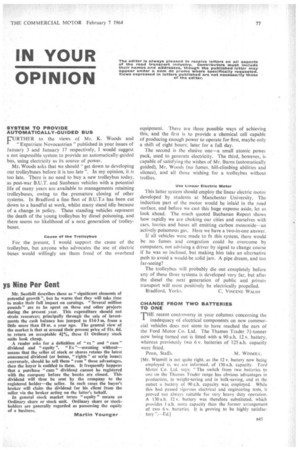IN YOUR OPINION
Page 79

If you've noticed an error in this article please click here to report it so we can fix it.
SYSTEM TO PROVIDE AUTOMATICALLY-GUIDED BUS
FURTHER to the views of Mr. K. Woods and "Expatriate Novocastrian " published in your issues of January 3 and January 17 respectively, I would suggest a not impossible system to provide an automatically-guided bus, using electricity as its source of power.
Mr. Woods asks that we should "get down to developing our trolleybuses before it is too late ". In my opinion, it is too late. There is no need to buy a new trolleybus today, as post-war B.U.T. and Sunbeam vehicles with a potential life of many years are available to managements retaining trolleybuses, owing to the premature closing of other systems. In Bradford a fine fleet of B.U.T.s has been cut down to a handful at work, whilst many stand idle because of a change in policy. These standing vehicles represent the death of the young trolleybus by diesel poisoning, and there seems no likelihood of a next generation of trolleybuses.
Cause of the Trotkeybus
For the present, I would support the cause of the trolleybus, but anyone who advocates the use of electric buses would willingly see them freed of the overhead equipment. There are three possible ways of achieving this, and the first is to provide a chemical cell capable of producing enough power to operate for first, maybe only a shift of eight hours; later for a full day.
The second is the elusive one—a small atomic power pack, used to generate electricity. The third, however, is capable of satisfying the wishes of Mr. Burns (automatically guided), Mr. Woods (no fumes, hill-climbing abilities and silence), and all those wishing for a trolleybus without trollies.
Use Linear Electric Motor
This latter system should employ the linear electric motor developed by students at Manchester University. The induction part of the motor would be inlaid in the road surface, and before we cast this huge expense aside, let us look ahead. The much quoted Buchanan Report shows how rapidly we are choking our cities and ourselves with cars, lorries and buses all emitting carbon monoxide—an actively poisonous gas. Here we have a two-in-one answer.
If all vehicles were made to fit this system, there would be no fumes and congestion could be overcome by computers, not advising a driver by signal to change course if he was so inclined, but making him take an alternative path to avoid a would-be solid jam. A pipe dream, and too far-seeing?
The trolleybus will probably die out completely before any of these three systems is developed very far, but after the diesel the next generation of public and private transport will most positively be electrically propelled.
Bradford, Yorks. C. VINCENTWALSH
CHANGE FROM TWO BATTERIES TO ONE
THE recent controversy in your columns concerning the inadequacy of electrical components on new commer cial vehicles does not seem to have reached the ears of the Ford Motor Co. Ltd. The Thames Trader 7+-tonner now being turned out is fitted with a 90 a.h. 12 v. battery, whereas previously two 6 v. batteries of 125 al, capacity were fitted.
Penn, Staffs. M. WINMILL.
[Mr. Winmill is not quite right, as the 12 v, battery now being employed is, we are informed, of 130 a.h. capacity. Ford Motor Co. Ltd. says: 'The switch from two batteries to one on the Thames Trader range has obvious advantages in production, in weight-saving and in bulk-saving, and at the outset a battery of 90 a.h. capacity was employed. While this had passed rigorous electrical and engineering tests, it proved not always suitable for very heavy duty operation. A 130 a.h. 12 v. battery was therefore substituted, which provides 1 a.h more capacity than the former arrangement of two 6 v. batteries. It is proving to be highly satisfactory ".—Ed.]




















































































































